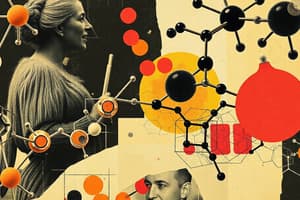Podcast
Questions and Answers
Which elements make up 96% of living organisms?
Which elements make up 96% of living organisms?
- Sulfur, Phosphorus, Calcium
- Carbon, Hydrogen, Oxygen, Nitrogen (correct)
- Oxygen, Nitrogen, Potassium
- Chlorine, Magnesium, Sodium
What are the building blocks of proteins?
What are the building blocks of proteins?
Amino acids
The process of removing water to join monomers is called _____ synthesis.
The process of removing water to join monomers is called _____ synthesis.
dehydration
Hydrolysis is an endergonic reaction.
Hydrolysis is an endergonic reaction.
What is the primary function of food in the body?
What is the primary function of food in the body?
Match the following types of compounds with their characteristics:
Match the following types of compounds with their characteristics:
What is the term for many monomers bonded together?
What is the term for many monomers bonded together?
Flashcards are hidden until you start studying
Study Notes
Elements of Life
- 96% of living organisms are made up of six elements: carbon, hydrogen, oxygen, nitrogen, sulfur, and phosphorus (CHONSP)
- Trace elements make up less than 0.01% of living organisms
- Oxygen makes up the largest proportion of living organisms at 65%
- Carbon makes up 18.5% of living organisms
- The human body is primarily composed of water, followed by carbon, oxygen, hydrogen, and nitrogen
Molecules of Life
- Organic molecules are made up of combinations of carbon, hydrogen, oxygen, and nitrogen
- Four major types of organic molecules are carbohydrates, proteins, lipids (fats), and nucleic acids (DNA and RNA)
- These molecules are created by bonding smaller molecules called monomers together to form larger molecules called polymers
- The process of joining monomers to form polymers is called polymerization
Monomers vs. Polymers
- A monomer is a single organic molecule.
- A polymer is a chain of many monomers bonded together.
- The process of building polymers from monomers is called dehydration synthesis, where water is removed and energy is used.
Dehydration Synthesis
- Dehydration synthesis is a process of building larger molecules (polymers) from smaller ones (monomers) by removing water.
- The process occurs by joining two monomers together, releasing a water molecule as a byproduct.
- Dehydration synthesis is an endergonic reaction, meaning it requires energy, which is typically provided by ATP.
- Dehydration synthesis is catalyzed by enzymes, which act as biological catalysts.
- Examples of dehydration synthesis include the formation of proteins from amino acids and the formation of carbohydrates from simple sugars.
Hydrolysis
- Hydrolysis is a process of breaking down polymers into smaller molecules by adding water.
- The process occurs by breaking the bonds between two monomers, adding a water molecule.
- Hydrolysis is an exergonic reaction, meaning it releases energy, which can be in the form of ATP.
- Hydrolysis is also catalyzed by enzymes.
- Examples of hydrolysis include the breakdown of starch into glucose and the breakdown of proteins into amino acids.
Why Do We Eat?
- We eat to obtain the building blocks and energy necessary for growth, repair, and cellular processes.
- Food provides the raw materials for building new cells and for energy production.
- Energy from food is stored in bonds and released through the process of hydrolysis to produce ATP, which is the energy currency of cells.
Matter in the Human Body
- Matter in the human body is made up of either inorganic or organic compounds.
- Inorganic compounds are compounds that generally do not contain carbon.
- Organic compounds are compounds that contain carbon.
- Organic compounds include carbohydrates, proteins, lipids, and nucleic acids These are the four major classes of biomolecules.
Arrangement of Elements in Organic Compounds
- Carbon atoms can bond to other atoms in chains or rings.
- This allows for the creation of a vast diversity of organic molecules with various structures and functions.
Studying That Suits You
Use AI to generate personalized quizzes and flashcards to suit your learning preferences.



